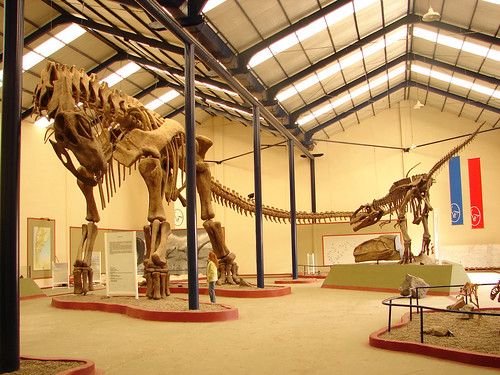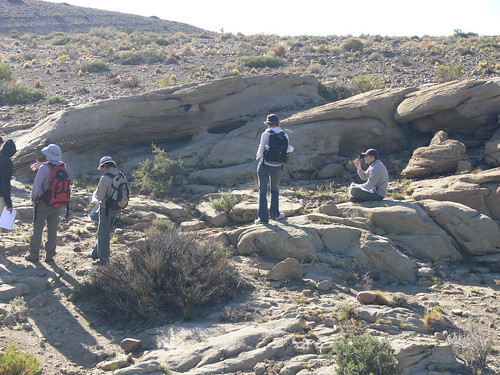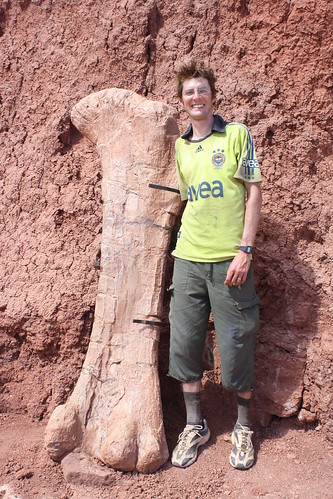
For the past few years has been developing slowly in the province of Neuquen an activity that was unthinkable 15 years ago. We’re talking Paleontological Tourism, a resource that is an affordable alternative to the desert areas of Argentina. Today we can say that the province is leading in places as to paleontological resources due to the unceasing work of paleontologists, who have allowed the continued input of libraries allowing the construction of museums, plus spectacular pieces themselves year after year.
This development of paleontology as a science has been accompanied by the necessary infrastructure for the tourist to feel comfortable in the places they visit. The place has enough information to route the same as some places are not the best, the quality of services is low, no hotels to accommodate visitors, and so on. This problem arises in that these desert cities are only prepared to accommodate merchants and are used as cities in the mountainous area step. In this way, never prepared to receive tourists who would stay overnight and visit to paleontological resources in the area.
Obviously there is much to do and everything is solvable, provided that the necessary precautions are taken to offer the tourist that comes to search. Today the province has 5 paleontological museums, all in different national and provincial routes allowing visitors can always visit at least some of the paleontology of Neuquen.
In Neuquén, there are four museums devoted especially to the dinosaurs: Villa El Chocon, Lake Barreales, Plaza Huincul, Rincon de los Sauces and one dealing with emphasis on marine reptiles that lived alongside dinosaurs in the city of Zapala.

Each museum has its own characteristic that individually with respect to the other. Villa star Chocón paleontology is the world’s largest carnivore, the Giganotosaurus carolinii, and numerous dinosaur footprints, Plaza Huincul the world’s largest herbivore, the A. huinculensis, Rincon de los Sauces to titanosaurus most comprehensive in the world and Finally, Lake Barreales, which not only shows spectacular fossil pieces but has the most comprehensive herbivorous world, Futalognkosaurus dukei, one of the most spectacular carnivores, the Megaraptor namunhuaiquii, the oldest titanosaurus the Andesaurus delgadoi, and tens of unique species that are references in the world. These matters Dino Project, the only dinosaur excavation open at any time in the world. Meanwhile Zapala has a collection of reptiles and marine invertebrates more important in South America.
Despite all this spectrum paleontological circuits are poorly developed, no services, no adequate forcible detention, or information for tourists and often do not know how to reach those destinations. The interesting thing is that this problem needs to be done and what good would be planned with professionals in the various issues involved so that this product is different and paleontological special attractions.
Today paleontology is part of desert tourism in Neuquen, but there is another branch of Natural Science is a virgin and would be an excellent complement. We refer to the Tourism Geological highly developed in Europe but almost nonexistent in Argentina. Neuquén is considered today as an open book of geology where you can see and touch all the rocks and geological structures of this Science.

Unlike geology paleontology is present in every corner of the province, and if we can not simple questions but few answers for example, in our valleys, (rivers Limay, Neuquen and Rio Black):
Why acreage lies on its northern shore and not on the South?
Why are there dinosaurs in the area if they have millions of years old?
How many volcanic vents has Auca Mahuida complex-and so on.
If we go towards the mountains we ask:
How old is the lake?
What was there before?
When and How are incurred in the Andes?
Why are there marine fossils near Zapala and even a coral reef?
What does it mean?, Etc..

Neuquen Province is supremely important geology and paleontology of Argentina, only need to know and be able to explain that in a not too distant future is a giant natural park where science, nature and knowledge come together to give a Tourism Excellence!.
Leave a Reply
You must be logged in to post a comment.
Recent Comments